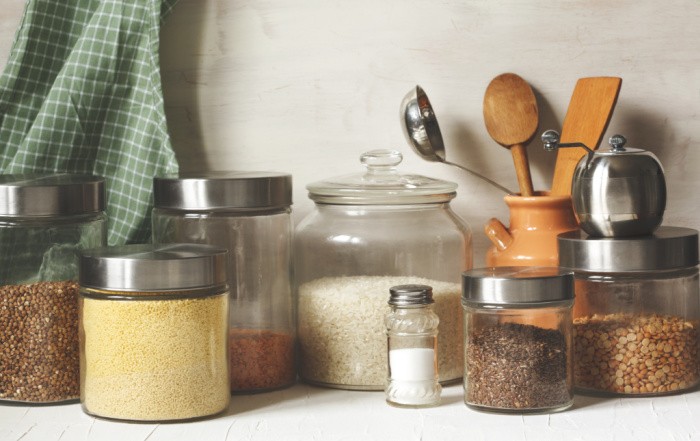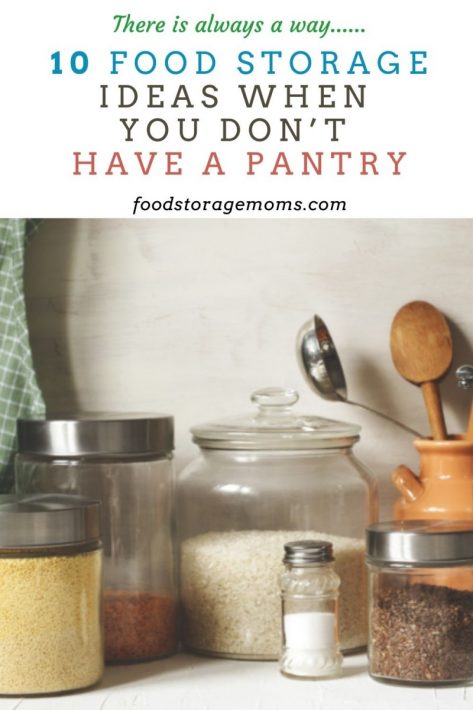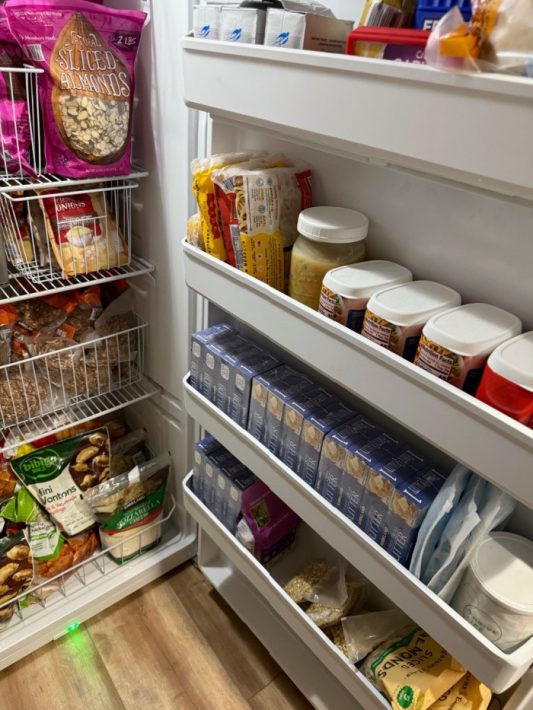
Not everyone has a pantry in their home. Some houses just weren’t built with one. Pantries are so convenient, primarily if they are located in your kitchen or very close by. It makes meal prep so much easier since you can see what’s there and don’t have to go to a basement or other storage area.
Most of my homes have had some sort of pantry available for me, but I’ve always wished they were larger based on how much I cook.
A dedicated pantry is nice but not necessary in the prepping world. We are capable of turning any space into a pantry.
To me, a pantry is almost any space you can store food that doesn’t need to be kept in a freezer or refrigerator. If you cook a lot, having those staples we use so many recipe options should be stored as close as possible. The more efficiently we can store food at home, the less often we visit the grocery store. So, we still need our freezer stocked.
Please don’t plan to store perishable items, like eggs, cheese, or other dairy products like yogurt and sour cream, since all these should be kept in your fridge unless they’ve been freeze-dried. I have tons of freeze-dried foods stored in #10 cans, and I love them. But they are costly these days.
Because prepping is so important, I have devised 10 food storage ideas when you don’t have a pantry. Please keep more than one can opener in your home.

Small Can Opener, a Larger Can Opener for #10 cans, and an Electric Can Opener
11 Canned Meat Ideas I Recommend
10 Awesome Facts About Canned Foods
Food Storage Ideas When You Don’t Have a Pantry
If you don’t have a pantry for your food storage, don’t worry! Here are 10 ideas that will make storing your extra food a breeze!
1. Use an Old Bookshelf
An old bookshelf can become a great place to store some food. Even in a small kitchen, you can stick a bookcase along one of your walls. Load your shelves with dry goods, canned goods, and dehydrated produce.
I recommend getting a bookshelf from the thrift store or Facebook Marketplace if you don’t have one and want a cheaper option.
If you have an IKEA near you, they have some inexpensive, sturdy bookcases to store food. If you get the taller ones, please attach them to the wall for safety reasons.
2. Store it in the Walls
You can take out part of your wall between two beams and then place shelves between the beams that you can use to store your food. This is a terrific option if you have a tiny kitchen and can’t put anything else into it.
The main challenge is how narrow the shelves would be. Additionally, you can add some hanging doors, like sliding barn doors, to hide what you have. This can be done reasonably quickly and with limited funds. Be sure to watch out for electrical wires in those walls.
3. Pegboard Food Storage Ideas
If you don’t want to tear out some sheetrock from your wall, you can use the exterior to create your pantry. Securely attach a pegboard to your wall. Create a pantry with baskets and shelves that will work with your food storage type.
You can create shelves for your canned goods and hang small buckets or baskets on the pegs for your produce. You can also hang flexible cloth bags to store spaghetti noodles or cutting boards.
4. Repurpose Your Coat Closet
I had a friend who didn’t have a pantry, but she had two coat closets—one by the front door and one by the back door. Instead of using both closets for coats and things, she uses one closet as a pantry.
Add shelves in your closet designed to store different sizes of products. You can buy bare wood boards and create shelves to hold baskets, canned goods, spices, or anything you want in your makeshift pantry.
Many “pantries” in homes now are the same size as my friend’s closet. If you’re lucky, your home has high ceilings, including the inside of your closets. Put some of the less used items in your food supply to be stored on the upper shelves or the floor.
5. Utilize an Enclosed Porch
You have to be careful what you put on the porch, primarily if you can’t regulate temperatures in your porch area. However, you can put up storage shelves to store your extra canned goods, dry goods like pasta, grains, lentils, white rice, beans, cleaning supplies, or things you frequently use, like paper towels or toilet paper.
You won’t want to have things in the cold or super-hot temperature periods since the temperature could affect the nutrients in the foods. If the temperature stays close to the inside room temperature, many items will have a decent shelf life. If you can keep it reasonably cool or warm throughout the year, this is an option to store your extra stuff.
If you picture storing some kitchen items that take up space, like toasters, slow cookers, pressure cookers, etc., this could be a great storage option, mainly if the porch is towards the rear of your home, where many kitchens are located.
6. Food Storage Ideas in the Basement
Using your basement for your extra food storage is a great idea. However, you’ll want to keep your food off the floor on 2″ x 4″ boards or pallets. Be sure you have a rotation plan in place so you don’t forget what’s downstairs.
One thing I’ve found about storing extra food in the basement is that sometimes you don’t feel like going down there to rotate your food, let alone frequent trips to grab the ingredients for that next meal.
I’ve kept so many items on the basement shelves that I’ve bought them at the store during case lot sales or canned them on my own. Canned goods include various veggies like tomatoes, potatoes, peas, carrots, onions, corn, green beans, etc.
I’ve also stored many types of fruits like apples in sauce, pears, berries, peaches, citrus items like mandarin oranges, and even canned meats like chicken, beef, pork, and tuna.
If you plan to store items like flour, oats, whole wheat, etc., use BPA-safe food storage containers with a tight seal and a date noted on the top or side.
I seldom keep flour for over a year, but rice, wheat, and pasta will last much longer, especially if they are commercially packaged. I also will store other commercial products like peanut butter, jams, jellies, mushrooms, etc.
This is a fabulous option if you can stay on top of what’s in your food storage inventory, even when it’s out of sight. There are several ways you can store food in your basement:
- Build a pantry in your basement. You can build a room in your basement solely dedicated to food storage.
- Add bookshelves. You can create your pantry in your basement if you have extra bookshelves.
- Hang shelves. If you don’t want things on the floor, you can use the walls and create shelves in your basement.
- Unused bedroom. If you’re in a new phase and don’t need those basement bedrooms for kids, consider converting one or more.
- Long-term storage. The basement may be your best option for the things you’re storing for the long haul or items you don’t use as often.
Years ago, I had a basement; it was a great food storage place and a great place to store extra coats and blankets, hygiene products, emergency preps, and more. Then, Mark and I downsized to a smaller home, and we didn’t have a basement. My dream would be to have a pantry that is 14 feet by 14 feet. It’s not going to happen, but I can dream, right? Such is life. My home is much smaller but easier to clean.
We have now downsized again, as I mentioned about 3 years ago. We have 1000 square feet with one wall designated for food storage. No pantry, just a wall, but I can see what we have, and that’s a blessing.
7. Hang Goods Under Your Cabinets
Screw mason jar lids into the bottom of your upper cabinets. Then, you can have instant storage for the things you use most often. I wouldn’t suggest doing a ton of stuff stored this way due to the weight.
But this is a good option for people with limited storage space. I’d suggest using wide-mouthed jars, but you might want to start with smaller/shorter pint jars before trying quarts.
8. Place Shelves Anywhere You Can
When it comes to prepping, you don’t have to figure out what to do with items in your kitchen. Your whole house can become a food storage haven! Hang shelves wherever you can to store extra food and prepping stuff. Here are some places you can hang extra shelves in your home:
- Build shelves on the sides of your cabinets.
- Narrow shelves can be placed along your backsplash between the cabinets and counter.
- You can add extra shelves in closets.
- Put up shelves above your toilet.
- Anywhere there is a wall, you can add a shelf for storage. Stir clear of hallways, which could be a safety hazard, particularly at night.
- We have items stored behind our entertainment center in the master bedroom. Who would have thought?
- We have BlueCan boxes lined on a wall in our Master Bedroom. That’s how I roll.
9. Build Your Pantry
You can always build your own or several if you have somewhere to put it. If the outside is your only option, take the items you seldom use or those that aren’t as “weather/temperature” sensitive and put them in the outside enclosure.
You can call these sheds or a pantry; they can serve a similar purpose if the items stored are safely kept there. My only concern is keeping the food cool enough; this would have to be your last resort to store your food outside. Families have built enclosed rooms in their garages and added ventilation and a small air conditioning unit.
10. Use Baskets and Containers
There are so many ways you can store extra food and essentials. Use baskets and plastic containers to store food in hard-to-reach cabinets so that you are using all of your space. You can even use plastic bins to scoot under the bed, couch, or shelves. Store it, stack it, and hide it however you can. I use baskets in my freezer as well.

Final Word
Finding all the right places to store your extra food can be challenging. Some of us live in tiny houses, some in apartments, and others have difficulty going up and downstairs.
When it comes to food storage, make it logical and efficient for you! If you need to build more shelves, do it. If you want to store it in an empty bedroom, do it. The best thing you can do is be creative as you figure out how to store it any way you can. May God Bless this world, Linda
Copyright Images: Glass Jars AdobeStock_266580193 by Anjelika Gretskaia
The post 10 Food Storage Ideas When You Don’t Have a Pantry appeared first on Food Storage Moms.
from Food Storage Moms
No comments:
Post a Comment